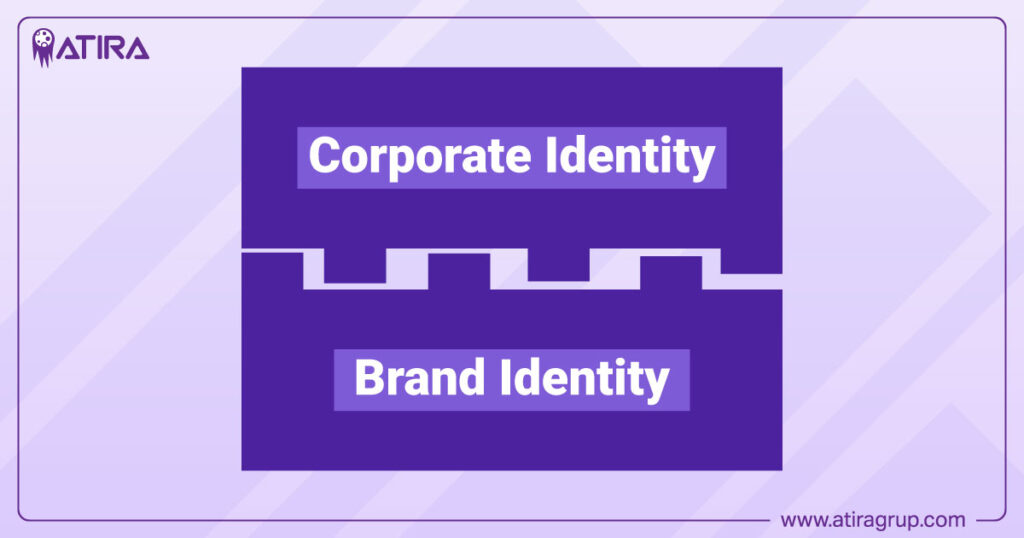Corporate identity shapes how a company is perceived through its visuals, communications, and behavior. It’s crucial for differentiating from competitors. This article explores key elements and best practices for building and maintaining a strong corporate identity.
Key Takeaways
- A strong corporate identity combines visual elements, corporate communications, and corporate behavior to create a cohesive and recognizable brand presence.
- Key components of corporate identity include consistency, recognition, effective messaging, and alignment with corporate culture, which improves stakeholder trust and loyalty.
- Developing and maintaining a corporate identity strategy involves conducting brand audits, defining clear brand objectives, and implementing comprehensive brand guidelines to ensure uniformity across all platforms.
Table of Contents
Understanding Corporate Identity
Corporate identity is more than just a logo or a catchy tagline; it is a strategic blend of various elements that collectively shape how a company is perceived by its stakeholders. At its core, corporate identity encompasses visual identity, corporate communications, and corporate behavior, all working together to create a cohesive and recognizable brand presence. This multifaceted approach ensures that the company’s values and personality are consistently communicated across all touchpoints.

A strong corporate identity speaks to easy recognition by the target audience and differentiation from competitors. It involves not only the design elements like logos and color schemes but also the communication style and organizational culture. In essence, it is the most valuable asset a company possesses, shaping the overall impression formed by consumers from various sources.
Visual Identity
Visual identity is the most immediately noticeable aspect of a strong corporate identity. It includes the company logo, color schemes, typography, and other design elements that represent the brand. These corporate visual identity elements should be thoughtfully crafted to align with the brand’s message, ensuring that they reinforce recognition and trust among stakeholders.
Logos, in particular, serve as mainstream identifiers and valuable assets, encapsulating the essence of the corporate brand identity. A well-designed logo and consistent corporate design can make your visual assets stand out, enhancing brand recognition and creating a lasting impression on external stakeholders.
Corporate Communications
Corporate communications play a critical role in shaping a consistent message for both internal and external audiences. Effective corporate communication ensures that the company’s values and mission are conveyed clearly and consistently, minimizing confusion and enhancing trust. This involves not only traditional media relations but also social media interactions and internal communications within the company.
Corporate communications aim to establish a unified company identity. It also focuses on maintaining that identity over time. Consistently voicing concerns and values helps companies foster a favorable point of view among stakeholders, thereby strengthening their corporate image.
Corporate Behavior
Corporate behavior reflects the company’s philosophy and values, influencing how it interacts with the public and its stakeholders. This includes the company’s mission statement, ethical code of conduct, and corporate social responsibility initiatives. Aligning corporate behavior with the company’s values is crucial for maintaining trust and integrity.
An organization’s culture, encompassing shared values and practices, guides daily operations and interactions. When corporate behavior aligns with the company’s values, it can significantly improve public perception and customer loyalty.
Corporate Identity vs Brand Identity
Understanding the difference between corporate identity and brand identity is essential for cohesive brand management. Corporate identity represents the overall company, including its culture, communication, and design elements that shape public perception. It is the collective image of the entire organization.

On the other hand, brand identity focuses on how an organization wants its specific products to be perceived, emphasizing particular characteristics and ethics. While corporate identity refers to the entire organization, brand identity is specific to individual brands.
However, both share visual elements like logos and color palettes for consistency, ensuring a cohesive brand identity and a unified brand presence.
Key Elements of a Strong Corporate Identity
A strong corporate identity is built on several key elements:

- Consistency, which ensures that all brand elements align with the company’s core values and are presented uniformly across all platforms.
- Recognition, which helps customers identify and remember the brand.
- Visuals, which include logos, colors, and design elements that represent the brand.
- Messaging, which conveys the brand’s values and mission to the audience.
This not only helps in maintaining brand integrity but also in building trust and loyalty among customers.
Recognition is achieved through well-designed logos and visual elements that are simple yet meaningful. Colors and fonts play a vital role in conveying the brand’s personality, while clear and consistent messaging ensures that the company’s values and mission are communicated effectively.
Company Logo and Design
A well-crafted logo creates a strong first impression and establishes authority in the company’s niche. The visual identity of a company is primarily represented through its logo and accompanying design elements. For example, Coca-Cola’s iconic brand identity is recognized worldwide for its distinctive logo and consistent messaging.
However, it’s important not to overcomplicate the corporate identity design, as this can alienate potential customers. Simplicity and clarity in design elements are key to making a lasting impression.
Brand Voice and Messaging
A unique brand voice ensures that messaging aligns with the company’s core values and engages the intended audience. Crafting messages that resonate effectively with the target audience requires a distinct and consistent brand voice.
Furthermore, clear brand objectives help in aligning marketing efforts with what the company aims to achieve. This alignment is crucial for maintaining a strong brand identity and ensuring that all communications reflect the company’s mission and vision.
Corporate Culture
Corporate culture is defined by the company’s basic values and specific rules of conduct. Aligning corporate culture with brand identity strengthens corporate identity and fosters employee loyalty. The values and norms that make up a company’s philosophy shape its core purpose beyond profit.
An effective corporate culture can guide design teams and ensure that internal actions align with the company’s identity. For instance, Starbucks cultivates a welcoming culture that engages employees and enhances its corporate identity.
Developing Your Corporate Identity Strategy
Developing a corporate identity strategy involves several crucial steps, starting with conducting a brand audit to evaluate the current corporate identity and identify areas for improvement. Setting clear brand objectives is essential to ensure that the corporate identity aligns with the company’s vision and mission.

Designing visual elements that reflect the brand’s personality and ensure consistency across all platforms is another critical step. By following these steps, companies can create a cohesive and strong corporate identity that resonates with their audience.
Conducting a Brand Audit
The purpose of conducting a brand audit is to review and evaluate the current corporate identity. This involves assessing whether the logo is outdated and if the brand colors, typography, and voice reflect the brand’s personality.
A brand audit involves examining existing brand materials. This includes logos, color palettes, typography, marketing collateral, and internal documents. Feedback from stakeholders, employees, and customers is crucial to identify inconsistencies and areas for improvement.
Defining Brand Objectives
Defining brand objectives involves conducting market and competitor research to understand the target audience’s needs and preferences. These objectives should align with the company’s overall mission and vision, ensuring that all branding efforts are cohesive and purposeful.
Clear brand objectives help in aligning marketing efforts with what the company aims to achieve, ensuring that all communications reflect the company’s core values and resonate with the target audience.
Designing Visual Elements
Logo, colors, and fonts are key visual elements that form the foundation of a corporate identity. Collaborating with designers to develop visual identifiers that accurately represent the brand is essential.
A brand portal simplifies updates and distribution of brand elements, ensuring that visual consistency is maintained across all platforms. Regular updates to corporate identity elements in response to market changes are necessary to stay relevant.
Implementing and Maintaining Your Corporate Identity
Implementing and maintaining a corporate identity requires careful planning and consistent effort. Here are some critical steps to consider:

- Establish comprehensive brand guidelines.
- Train employees on the brand’s values and messaging.
- Use digital asset management systems to organize brand materials.
- Regularly monitor and update corporate identity to stay relevant and competitive.
By following these steps, you can ensure a strong and consistent corporate identity.
Consistency in brand communications is crucial for building recognition and trust with the audience. A central approval process ensures that all brand-related content meets established standards, preventing inconsistent messaging.
Establishing Brand Guidelines
A uniform corporate design significantly increases recognition value and saves time and money. Brand guidelines for visual elements should include logo usage, color codes, typography rules, and templates to ensure consistency.
These guidelines should be easily accessible to all employees to maintain a consistent corporate identity across all platforms. Consistency in typography and other visual elements creates a visually appealing and coherent brand identity.
Training Employees
Training employees on corporate identity encourages a culture of brand ambassadorship. Inadequate training can lead to inconsistent representation by employees.
Training sessions should include an explanation of brand guidelines and demonstration of correct usage. Resources such as brand manuals and online tutorials can reinforce branding training and ensure consistent representation.
Using Digital Asset Management Systems
Digital tools like a brand portal or a Digital Asset Management (DAM) system are essential for organizing brand assets and maintaining guidelines. DAM systems facilitate the efficient management of brand assets and enhance collaboration among teams. These systems streamline the process of accessing and sharing branded materials across teams, ensuring consistency and efficiency in brand management.
A DAM system is specifically used for managing and organizing brand assets, making it easier to maintain a cohesive corporate identity.
The Impact of Corporate Identity on Business Success
A strong corporate identity enhances customer loyalty and helps establish a strong connection with the audience. Positive brand reputation can drive customer loyalty and repeat purchases, ultimately influencing profitability. Companies with a distinct corporate identity often see improved market recognition, attracting new customers and providing a competitive edge.

Effective corporate communication fosters transparency, enhancing stakeholder trust. Employee training on corporate identity can significantly improve brand representation and engagement, contributing to a cohesive perception of the company in the marketplace.
Examples of Successful Corporate Identities
Apple and Starbucks are prime examples of companies with strong corporate identities. Apple emphasizes exclusivity and community engagement, creating a loyal customer base and a distinct brand presence. Starbucks, on the other hand, maintains a consistent brand atmosphere and commitment to social responsibility, fostering trust and loyalty among consumers.

Both companies illustrate how a strong corporate identity can enhance customer connection and brand loyalty. Maintaining a consistent corporate identity across all touchpoints has helped these companies establish themselves as leaders in their respective industries.
Apple
Apple’s corporate identity is built around an exclusivity formula that emphasizes premium products and high customer expectations. This approach has cultivated a strong community of loyal users who are willing to pay a premium for Apple products. Apple’s sleek, minimalist design and user-centric approach to product development have set it apart from competitors, creating a unique and powerful brand identity.
In addition to its exclusivity, Apple engages in community responsibility by providing educational programs to support development and learning. This commitment to social responsibility further enhances Apple’s corporate image and strengthens its connection with customers, reinforcing its position as a leader in innovation and technology.
Starbucks
Starbucks has established a consistent corporate identity through its brand design and corporate message across locations. The company logo, the ambiance of its stores, and the barista interactions all contribute to a unique and uniform customer experience. This consistency in branding contributes significantly to Starbucks’ reputation and trustworthiness among consumers.
Moreover, Starbucks engages in social responsibility efforts by providing employment opportunities for refugees. This commitment to social causes not only enhances its corporate identity but also resonates with its customers, who appreciate the company’s values and efforts to make a positive impact on society.
Common Pitfalls in Corporate Identity Management
Neglecting corporate identity management can lead to devastating consequences both internally and externally for brands. Companies often overlook the importance of managing their corporate identity until a crisis forces them to confront issues. A poor customer experience and a disjointed marketing strategy can result in brand devaluation. Additionally, a lack of corporate communications further threatens corporate identity.

Social media poses additional risks, such as potential brand infringement and damage from online scammers or disgruntled consumers. Having a corporate identity protection strategy is crucial to mitigate these risks and maintain a strong brand presence.
Managing digital identity should be a top priority for companies to avoid pitfalls and ensure a consistent brand image.
Summary
In summary, creating a strong corporate identity involves a strategic blend of visual identity, corporate communications, and corporate behavior. It is essential for companies to develop a cohesive corporate identity strategy that includes conducting a brand audit, defining brand objectives, and designing visual elements. Implementing and maintaining this identity requires comprehensive brand guidelines, employee training, and the use of digital asset management systems.
A strong corporate identity not only enhances customer loyalty and market recognition but also differentiates a business from its competitors. By learning from successful examples like Apple and Starbucks and avoiding common pitfalls, companies can build and sustain a corporate identity that drives long-term business success. Remember, a well-defined corporate identity speaks volumes about your company’s values and commitment to excellence.
Read more:
Creating A Strong Brand Image: Key Elements & Practical Tips
Frequently Asked Questions
What is the difference between corporate identity and brand identity?
Corporate identity encompasses the company’s overall ethos, culture, and communication strategies, whereas brand identity is concerned with the perception of specific products. Understanding this distinction is crucial for effective branding and corporate strategy.
Why is a strong corporate identity important?
A strong corporate identity is crucial as it fosters customer loyalty and sets the business apart from competitors, creating a cohesive and recognizable brand presence. This distinct identity ultimately strengthens the organization’s market position and connection with its audience.
What are the key elements of a strong corporate identity?
A strong corporate identity is defined by a well-designed logo, a unique brand voice and messaging, and a corporate culture that reflects the company’s core values. These elements work together to create a cohesive and recognizable brand presence.
How can companies maintain a consistent corporate identity?
To maintain a consistent corporate identity, companies should establish comprehensive brand guidelines, provide employee training, and implement digital asset management systems for efficient organization of brand assets. This approach ensures that all aspects of the brand are coherent and aligned.
Can you provide examples of successful corporate identities?
Apple and Starbucks exemplify successful corporate identities through their focus on exclusivity, community engagement, and social responsibility. Their strong brand identities have significantly contributed to their market presence and customer loyalty.


